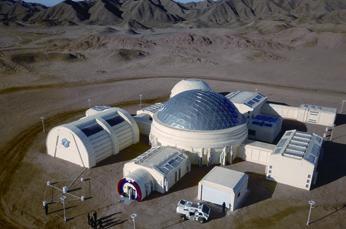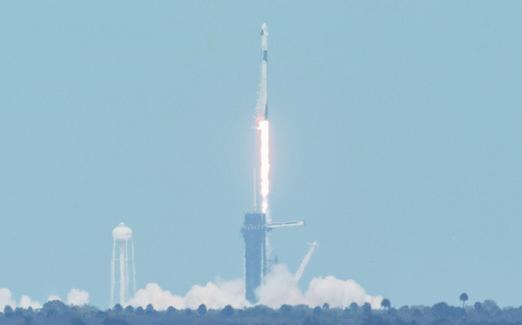Giant Leaps for Progress
By Josef Gregory Mahoney


On May 30, U.S. space agency NASA in partnership with Tesla CEO Elon Musks other company, SpaceX, sent two astronauts to the International Space Station (ISS), the multinational space laboratory in Earths orbit.
Much has been made of the publicprivate partnership represented by SpaceX playing such a prominent role. In fact, U.S. companies have always manufactured vehicles for NASA. For example, the firms North American Rockwell and U.S. Northrop Grumman constructed the launch vehicles for the Apollo 13 mission in 1970, where the spacecraft was planned to land on Moon but the mission was aborted when an oxygen tank failed. Rockwell was also the main builder of the ill-fated Columbia, the first shuttle to reach space in 1981 but which disintegrated before returning to Earth in 2003, tragically killing its seven-member crew and ending U.S. launches of manned vehicles until this day. Private firms were also there throughout for the incredible successes, including lunar landings and a host of other major accomplishments in outer space.
After the Columbia tragedy, the U.S. relied on Russian launch services to send crew to the ISS, jointly built and used by NASA and the space agencies of Russia (Roscomsos), Japan (Japan Aerospace Exploration Agency), Europe (European Space Agency-ESA) and Canada (Canadian Space Agency). This project was possible only in the mid-1990s after the dissolution of the Soviet Union, and despite the ups and downs in U.S.-Russia relations, it has served as a powerful example of international cooperation despite revealing to former enemies highly sensitive technology.
To date, more than 240 people from at least 19 countries have spent time at the ISS. However, no Chinese have been allowed to visit the station. Despite a brief window in 2010 when the ESA director proposed China be allowed to join the ISS, the U.S. has consistently blocked this from happening. In 2011, it passed legislation making it illegal for NASA to cooperate with China on space projects.
That same year, China launched its first space lab, Tiangong-1, followed by Tiangong-2 in 2016. The first module of a new station is expected to be launched in 2021.
U.S. space force
During the coldest days of the Cold War in the 1980s, soon after U.S. President Ronald Reagan was reelected in 1984, the Space Command was established to lead U.S. space-related military interests. In 2002, however, with the Cold War over and the U.S. instead focusing on the “war on terror,” the command was dissolved, with its functions absorbed by various military units.
In 2019, however, President Donald Trump reestablished the command, with supporting legislation signed that year and complemented with the creation of a new branch of military, the U.S. Space Force. With these two components now in place, American hawks have scored major steps toward advancing war-f ighting capabilities in space.

However, these seem to be steps backward and not forward. While onward and outward has always represented a futureoriented humanity, the new militarization of space along national lines once more projects destructive practices in ways and places where such foolishness should be transcended. This path appears especially ominous, given the growing U.S.-China tensions and perhaps even a Cold War 2.0, and overlaps with a new arms race emerging between ISS partners Russia and the U.S., in tandem with the duo abandoning arms control treaties while developing new war-making technologies.
This follows, unfortunately, an executive order signed by Trump in April, also contrary to longstanding international treaties, that allows U.S. companies to claim and exploit mineral rights on Moon and other astral bodies.

And all of this transpires while the Trump administration blames China for the worlds problems, claims that the novel coronavirus disease (COVID-19) constituted a deliberate attack on American worse than Japans attack on Pearl Harbor in 1941, and has repeatedly asserted, contrary to evidence, that these actions form part of a larger Beijing-led conspiracy to export Marxism and communism globally and rule the world.
Red planet missions
Mars is named after the Roman version of the ancient Greek god of war, Ares. In fact, archaeological evidence indicates the ancient Sumerians, people of southern Mesopotamia whose culture preceded the ancient Greeks by an estimated two millenniums, saw the planet as Nergal, the god of war and plague. In China, Mars came to be called Huoxing, or “fi re planet,”given its red color.
To date, only two countries, the U.S. and Russia, have successfully landed unmanned vehicles on Mars. In 2003, the ESA successfully put a satellite in Marss orbit, and India accomplished the same in 2014. Currently, SpaceX and separately, China, have plans for manned missions to the red planet in a decades time.
While Musks Tesla advances its cuttingedge development and production activities in China, where it has a new state-of-theart factory in Shanghai and works in close cooperation with the Chinese authorities, his SpaceX works with NASA to send Americans upward by way of Florida. This is but one of the ironies of todays world—that Musks SpaceX serves the nationalist fantasy while his Tesla serves the Chinese and global market but his real vision is to establish a new society off-world. How does this square with Trumps go-it-alone approach to space exploration and even, how hes responded to the COVID-19 pandemic and international trade? Where does a man like Musk fi t in the Make-America-Great-Again world that Trump seeks? Perhaps well remember Musk as a Martian after all.
China plans to launch an unmanned mission to land on and explore Mars later this year, perhaps as early as July. This mission, named Tianwen, represents an exciting development for Chinese space efforts, and should be hailed more broadly as another moment of human progress. Unfortunately, some will choose to characterize this mission as a threat.
Fear of a “red planet” has often driven U.S. space policy, from the space race with the Soviet Union to the exclusion of China from the ISS, and now the new efforts to prepare for space-fought wars and likely projecting environmentally destructive and non-renewable resource extraction practices off-world.
As the U.S. sends its astronauts upward, as China moves toward Mars, as tensions increase with both terrestrial and extraterrestrial consequences, and as we dream of escaping our current crises, lets hope for successful missions that contribute to human progress without invoking war or fire or plague. Let us work for global peace and cooperation and ensure that the “giant leaps for mankind,” to paraphrase the first words on Moon by Neil Armstrong, the fi rst man to set foot on it, are truly moving us all forward and not backward.

